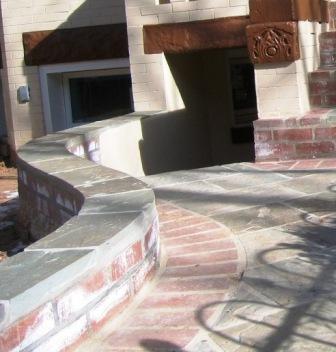 Here's an example of nice (in my opinion) work
that was rejected by the regulators. This is a front walk to a house on
18th Street with a basement entrance. The developer built a very nice curved
brick and cut-stone edging to the walkway.
Here's an example of nice (in my opinion) work
that was rejected by the regulators. This is a front walk to a house on
18th Street with a basement entrance. The developer built a very nice curved
brick and cut-stone edging to the walkway.
Why would anyone complain about this very nice-looking little wall? Built of brick and stone, it's certainly not "modern". What would anyone reasonably complain about? It's plain that I don't agree with this rigid imposition of uniformity on our neighborhood. Mount Pleasant is proud of its diversity, and even the petition for historic district designation notes the "medley of diverse building types, styles, forms, massing, and details" that characterizes our neighborhood. The Historic Preservation Office now demands that that "medley" of diversity be frozen rigidly in time, with no resident allowed to deviate from an ideal of peas-in-a-pod uniformity.
Well, complain they did. The Historic Preservation Office inspector, a fanatic for "repeated patterns" in this row-house district, asserted that this residence had to match its neighbors, which did not have such elegant stone- and brickwork edgings. The developer was forced to amputate that nice cut-stone top, then cover over the brickwork with bare concrete, so that his front walk would not be very different from his neighbors' front walks. The inspector objected also to those nice paving stones, but reluctantly allowed them to stay. Had this developer sought a permit in advance of the work, as he was supposed to do, he would have been told that paving stones are not allowed, either. Front walks are supposed to be plain, bare concrete, that being the utilitarian style of Mount Pleasant before 1950.
If someone wants to do something radical to his house, well, fine, let's object to anything that is ugly or, in the word that governs Massachusetts historic preservation law, "incongruous". But modest improvements by homeowners, enhancing the appearance or functionality of their residences, ought to be allowed, barring only radical, "incongruous" alterations.
This is where historic preservation has gone wrong. Even some residents who promoted historic district designation in 1986 here will now say that it has gone too far. The goal was the prevention of incongruous developments and alterations. Nobody wanted to see Mount Pleasant turned into a time capsule, a museum piece where residents cannot change a thing on their homes, but are forced to keep everything just as it was before 1950.
In March, 2007, I wrote up a short newsletter summarizing my concerns about historic preservation in Mount Pleasant.
More: a battle over windows erupted when a young couple, newly arrived to the neighborhood, replaced their leaky old windows with well-insulated thermopane. The neighbors are fine with that, as is the ANC, but not our band of preservationists.
In 2008 the historical preservationists of the Kalorama Citizens' Association (KCA) (another band of upper-class residents organized to impose their views on the rest of their neighborhood) set about making Lanier Heights, the northern portions of Adams Morgan, from Columbia Road to Harvard Street, a historic district. But residents of Lanier Heights got wind of the scheme and warned their neighbors of what was coming. I helped, with a report on the Mount Pleasant experience with being a designated historic district.
On September 15 the Adams Morgan ANC organized a meeting of residents to discuss this project. Some 70 or 80 people showed up, the great majority of them vehemently opposed to historic district designation. Residents of the western portion of Adams Morgan, lately designated the Washington Heights historic district, related their unhappy experiences since its designation. Advocates protested that historic preservation regulation was really gentle and easy to deal with, but the actual experience of residents of historic districts, including my report, refuted that assertion. Councilmember Jim Graham distributed a letter by him advising the Historic Preservation Review Board to refrain from making Lanier Heights a historic district. That ought to put an end to that.
Return to home
This page updated October 17, 2008